
A bottle of the 1981 vintage of Château Cheval Blanc
Château Cheval Blanc (French for “White Horse Castle”), is a wine producer in Saint-Émilion in the Bordeaux wine region of France. As of 2012, its wine is one of only four to receive the highest rank of Premier Grand Cru Classé (A) status in the Classification of Saint-Émilion wine, along with Château Angélus, Château Ausone and Château Pavie.
The estate’s second wine is named Le Petit Cheval.
History
In 1832 Château Figeac sold 15 hectares/37 acres to M. Laussac-Fourcaud, including part of the narrow gravel ridge that runs through Figeac and neighboring vineyards and reaches Château Pétrus just over the border in Pomerol. This became Château Cheval Blanc which, in the International London and Paris Exhibitions in 1862 and 1867, won medals still prominent on its labels. The château remained in the family until 1998 when it was sold to Bernard Arnault, chairman of luxury goods group LVMH, and Belgian businessman Albert Frère, with Pierre Lurton installed as estate manager, a constellation similar to that of the group’s other chief property Château d’Yquem.
Vineyard
The vineyard is considered to have three qualities: one third Pomerol as it is located on the boundary, one third Graves as the soil is gravelly, and the remaining third typical Saint-Émilion. The vineyard area is spread over 41 hectares, with 37 hectares planted with an unusual composition of grape varieties of 57% Cabernet Franc, 40% Merlot, and small parcels of Malbec and Cabernet Sauvignon. The average annual production is 6000 cases of the Grand vin and 2500 cases of the second wine, Le Petit Cheval.
Controversy

The Château Cheval Blanc
The manager of Château Cheval Blanc, Jacques Hebrard, was outraged at the evaluation of his 1981 vintage barrel samples made by influential wine critic Robert M. Parker, Jr. and asked him to re-taste. Upon arriving, Parker was attacked by Hebrard’s dog as the manager stood idly by and watched. When Parker asked for a bandage to stop the bleeding from his leg, Parker says Hebrard instead gave him a copy of the offending newsletter. Hebrard denies that Parker was bleeding. However, Parker did retaste the wine and found it significantly changed from his previous evaluation, and therefore gave the wine an updated evaluation in a later issue of his publication The Wine Advocate.

